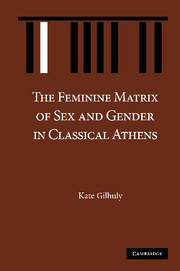Book contents
- Frontmatter
- Contents
- ACKNOWLEDGMENTS
- LIST OF ABBREVIATIONS
- 1 Introduction
- 2 Collapsing Order: Typologies of Women in the Speech “Against Neaira”
- 3 Why Is Diotima a Priestess? The Feminine Continuum in Plato's Symposium
- 4 Bringing the Polis Home: Private Performance and the Civic Gaze in Xenophon's Symposium
- 5 Sex and Sacrifice in Aristophanes' Lysistrata
- Conclusion
- BIBLIOGRAPHY
- INDEX LOCORUM
- SUBJECT INDEX
4 - Bringing the Polis Home: Private Performance and the Civic Gaze in Xenophon's Symposium
Published online by Cambridge University Press: 21 October 2009
- Frontmatter
- Contents
- ACKNOWLEDGMENTS
- LIST OF ABBREVIATIONS
- 1 Introduction
- 2 Collapsing Order: Typologies of Women in the Speech “Against Neaira”
- 3 Why Is Diotima a Priestess? The Feminine Continuum in Plato's Symposium
- 4 Bringing the Polis Home: Private Performance and the Civic Gaze in Xenophon's Symposium
- 5 Sex and Sacrifice in Aristophanes' Lysistrata
- Conclusion
- BIBLIOGRAPHY
- INDEX LOCORUM
- SUBJECT INDEX
Summary
INTRODUCTION
Xenophon's Symposium depicts an evening in 421/0 BCE on which Kallias hosts a group of illustrious Athenian men. The text portrays the entertainment he provided and the discussion it provoked among his guests, intertwining a narrative of the spoken with a narrative of the seen. The group that Kallias hosts is somewhat incompatible – sophists and Socratics, businessmen and philosophers, with entertainers to distract them. The evening proceeds in growing waves of tension that Socrates busily works to dispel. His success at managing the evening's difficulties is manifest in the way he transforms the evening's entertainment: the symposium begins with a static tableau and ends with an arousing performance in which the performers and spectators are mutually engaged.
The Symposium is concerned with elite exchange – the exchange of love, bodies, sex, friendship, education, and performance; exchange made for money or for charis; exchanges among the elite, and perhaps most important, those between the elite and the demos. The text depicts Socrates reconfiguring the relationship between the elite and the polis, advocating that the demos adopt the erotic and paedogogical practices of the elite and that the symposiasts embrace a distinctly civic formulation of heterosexual reciprocity. This new relationship culminates in a performance in which the hired entertainers dramatize the love between Dionysos and Ariadne. Significantly, Socrates’ prescription for an improved relationship between the demos and the elite is grounded in spectacle engaging (among other things) a spectrum of scripts for feminine performance.
- Type
- Chapter
- Information
- The Feminine Matrix of Sex and Gender in Classical Athens , pp. 98 - 139Publisher: Cambridge University PressPrint publication year: 2008



